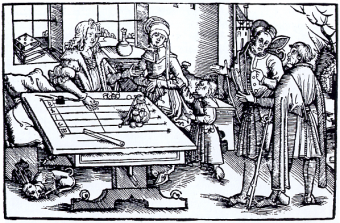Milestones:16-bit Monolithic DAC, 1981 and Category:Engineering fundamentals: Difference between pages
From ETHW
(Difference between pages)
No edit summary |
No edit summary |
||
| Line 1: | Line 1: | ||
== | == Background == | ||
[[Image: | [[Image:Rechentisch.png|thumb|right|340px|Woodcut showing use of an abacus]] | ||
Engineering requires many building blocks and tools. To produce real world results, one must practically apply mathematics and sciences to tangible problems and scenarios. Included in this category are the various technical topics which cut across engineering disciplines, encompassing many branches of mathematics and scientific disciplines. | |||
== Featured Articles == | |||
Featured articles are peer-reviewed articles on the history of major developments in technology. Available in the scientific tools and discovery category are: | |||
*[[Scanning Probe Microscopy]] | |||
== | == Subcategories == | ||
*'''[[:Category:Acoustics|Acoustics]]''' - The science of waves, subcategories include acoustic propagation, biomedical acoustics and nonlinear acoustics | |||
*'''[[:Category:Design methodology|Design methodology]]''' - Topics that pertain to design and creation, including critical thinking methods, sustainability and articulation. | |||
*'''[[:Category:Distillation|Distillation]]''' - The process of purification of liquids | |||
*'''[[:Category:Fields, waves & electromagnetics|Fields, waves & electromagnetics]]''' - The relationship between magnetic and electrical fields that provides the foundational theory of electrical engineering | |||
*'''[[:Category:Instrumentation|Instrumentation]]''' - Topics relating to devices used for measurement, such as oscilloscopes and probes | |||
*'''[[:Category:Kinetics & catalysis|Kinetics & catalysis]]''' - Various topics of energy related to applications in physics and chemistry | |||
*'''[[:Category:Lasers, lighting & electrooptics|Lasers, lighting & electrooptics]]''' - Topics relating to electric lighting, lasers and photonics | |||
*'''[[:Category:Mathematics|Mathematics]]''' - Mathematics such as calculus, algebra, and numerical analysis are all essential components of engineering | |||
*'''[[:Category:Measurement|Measurement]]''' - Related to instrumentation, measurements of various quantities has many real world applications | |||
*'''[[:Category:Mixing|Mixing]]''' - The combination of multiple materials to form a homogeneous solution | |||
*'''[[:Category:Particle technology & fluidization|Particle technology & fluidization]]''' - Sciences dealing with particulates and fluids | |||
*'''[[:Category:Process development|Process development]]''' - Disciplines related to the optimization of various engineering and scientific processes | |||
*'''[[:Category:Reaction engineering|Reaction engineering]]''' - Chemistry related topics dealing with the engineering of various reactions | |||
*'''[[:Category:Reliability|Reliability]]''' - The ability of a system or component to perform its required functions under stated conditions for a specified period of time | |||
*'''[[:Category:Scientific disciplines|Scientific disciplines]]''' - Various non-engineering scientific disciplines such as physics, chemistry, biology and astronomy | |||
*'''[[:Category:Separations|Separations]]''' - Topics in chemistry related to the separation of materials into distinct substances | |||
*'''[[:Category:Systems engineering and theory|Systems engineering and theory]]''' - An interdisciplinary method to engineering which has practical uses in complex projects which span multiple fields | |||
*'''[[:Category:Thermodynamics|Thermodynamics]]''' - a physical science that studies that effects on material bodies of transfer of heat and work | |||
*'''[[:Category:Transport and fluid mechanics|Transport and fluid mechanics]]''' - Topics concerning the mass and energy exchange between systems | |||
[[ | |||
[[ | |||
[[ | |||
[[Category: | |||
[[Category: | |||
Revision as of 19:41, 6 January 2015
Background
Engineering requires many building blocks and tools. To produce real world results, one must practically apply mathematics and sciences to tangible problems and scenarios. Included in this category are the various technical topics which cut across engineering disciplines, encompassing many branches of mathematics and scientific disciplines.
Featured Articles
Featured articles are peer-reviewed articles on the history of major developments in technology. Available in the scientific tools and discovery category are:
Subcategories
- Acoustics - The science of waves, subcategories include acoustic propagation, biomedical acoustics and nonlinear acoustics
- Design methodology - Topics that pertain to design and creation, including critical thinking methods, sustainability and articulation.
- Distillation - The process of purification of liquids
- Fields, waves & electromagnetics - The relationship between magnetic and electrical fields that provides the foundational theory of electrical engineering
- Instrumentation - Topics relating to devices used for measurement, such as oscilloscopes and probes
- Kinetics & catalysis - Various topics of energy related to applications in physics and chemistry
- Lasers, lighting & electrooptics - Topics relating to electric lighting, lasers and photonics
- Mathematics - Mathematics such as calculus, algebra, and numerical analysis are all essential components of engineering
- Measurement - Related to instrumentation, measurements of various quantities has many real world applications
- Mixing - The combination of multiple materials to form a homogeneous solution
- Particle technology & fluidization - Sciences dealing with particulates and fluids
- Process development - Disciplines related to the optimization of various engineering and scientific processes
- Reaction engineering - Chemistry related topics dealing with the engineering of various reactions
- Reliability - The ability of a system or component to perform its required functions under stated conditions for a specified period of time
- Scientific disciplines - Various non-engineering scientific disciplines such as physics, chemistry, biology and astronomy
- Separations - Topics in chemistry related to the separation of materials into distinct substances
- Systems engineering and theory - An interdisciplinary method to engineering which has practical uses in complex projects which span multiple fields
- Thermodynamics - a physical science that studies that effects on material bodies of transfer of heat and work
- Transport and fluid mechanics - Topics concerning the mass and energy exchange between systems
